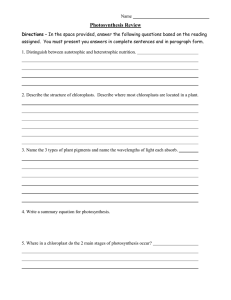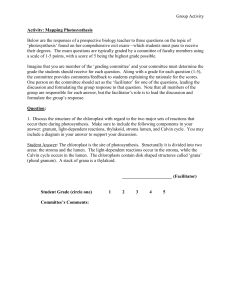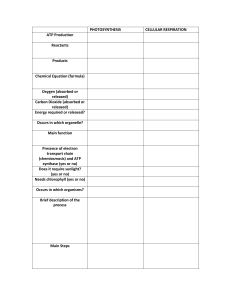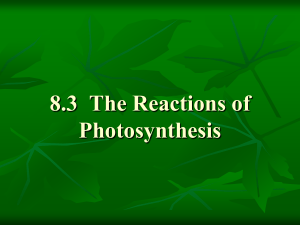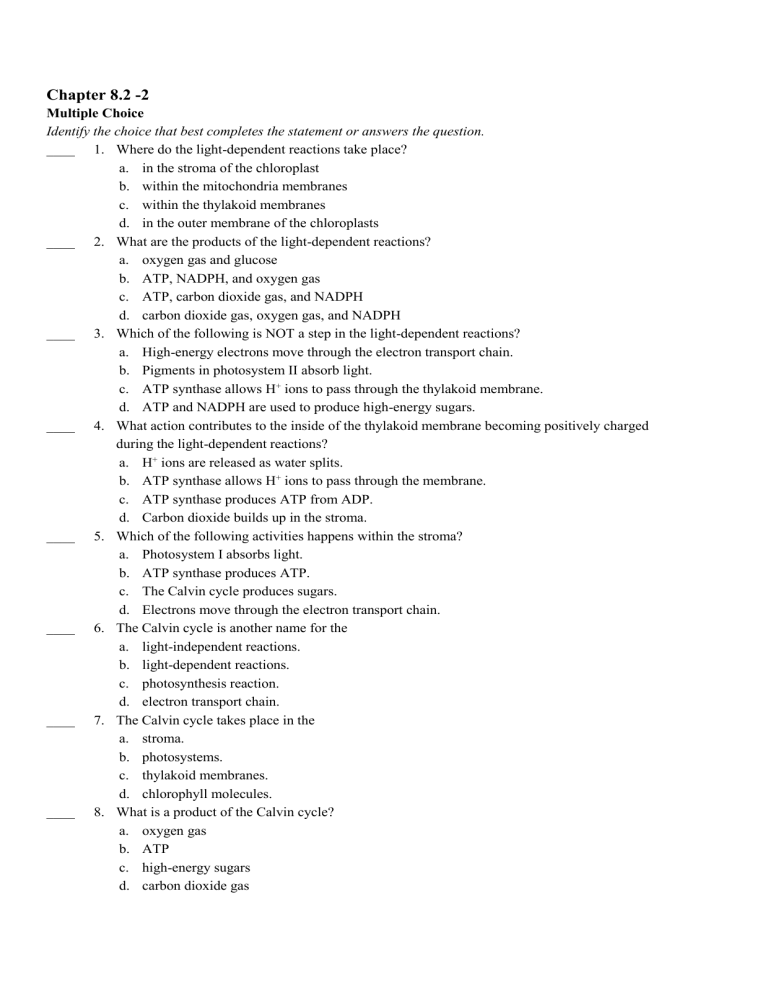
Chapter 8.2 -2 Multiple Choice Identify the choice that best completes the statement or answers the question. ____ 1. Where do the light-dependent reactions take place? a. in the stroma of the chloroplast b. within the mitochondria membranes c. within the thylakoid membranes d. in the outer membrane of the chloroplasts ____ 2. What are the products of the light-dependent reactions? a. oxygen gas and glucose b. ATP, NADPH, and oxygen gas c. ATP, carbon dioxide gas, and NADPH d. carbon dioxide gas, oxygen gas, and NADPH ____ 3. Which of the following is NOT a step in the light-dependent reactions? a. High-energy electrons move through the electron transport chain. b. Pigments in photosystem II absorb light. c. ATP synthase allows H+ ions to pass through the thylakoid membrane. d. ATP and NADPH are used to produce high-energy sugars. ____ 4. What action contributes to the inside of the thylakoid membrane becoming positively charged during the light-dependent reactions? a. H+ ions are released as water splits. b. ATP synthase allows H+ ions to pass through the membrane. c. ATP synthase produces ATP from ADP. d. Carbon dioxide builds up in the stroma. ____ 5. Which of the following activities happens within the stroma? a. Photosystem I absorbs light. b. ATP synthase produces ATP. c. The Calvin cycle produces sugars. d. Electrons move through the electron transport chain. ____ 6. The Calvin cycle is another name for the a. light-independent reactions. b. light-dependent reactions. c. photosynthesis reaction. d. electron transport chain. ____ 7. The Calvin cycle takes place in the a. stroma. b. photosystems. c. thylakoid membranes. d. chlorophyll molecules. ____ 8. What is a product of the Calvin cycle? a. oxygen gas b. ATP c. high-energy sugars d. carbon dioxide gas ____ 9. How does the Calvin cycle differ from the light-dependent reactions? a. It takes place in the stroma. b. It takes place in chloroplasts. c. It requires light. d. It requires water. ____ 10. If carbon dioxide is completely removed from a plant’s environment, what would you expect to happen to the plant’s production of high-energy sugars? a. More sugars will be produced. b. No sugars will be produced. c. The same number of sugars will be produced but without carbon dioxide. d. Fewer sugars will be produced at first, but then the plant will recover. ____ 11. If you continue to increase the intensity of light that a plant receives, what happens? a. The rate of photosynthesis increases indefinitely with light intensity. b. The rate of photosynthesis decreases indefinitely with light intensity. c. The rate of photosynthesis increases and then levels off. d. The rate of photosynthesis does not change. Figure 8–1 ____ 12. In which experimental setup shown above would you expect the Elodea plant inside the test tube to produce the LEAST amount of oxygen? a. A b. B c. C d. D Figure 8–2 ____ 13. Imagine that y-axis of each graph in Figure 8–6 describes the rate of photosynthesis. Which of the graphs represents the effect of temperature on the rate of photosynthesis? a. A b. B c. C d. D ____ 14. Imagine that y-axis of each graph in Figure 8–6 describes the rate of photosynthesis. Which of the graphs represents the effect of light intensity on the rate of photosynthesis? a. A b. B c. C d. D Modified True/False Indicate whether the statement is true or false. If false, change the identified word or phrase to make the statement true. ____ 1. The light-dependent reactions involve adding a hydrogen ion and two high-energy electrons to NADPH. _________________________ ____ 2. The six carbon atoms needed to make a molecule of glucose come from oxygen in the atmosphere. _________________________ ____ 3. ATP synthase changes ADP to ATP when light energy passes through it. _________________________ ____ 4. The light-dependent reactions supply the Calvin cycle with CO2 and ATP. _________________________ ____ 5. During the light-dependent reactions, plants use the energy in ATP and NADPH to build high-energy sugars. _________________________ ____ 6. The Calvin cycle provides cells with compounds that can store energy for more than a few minutes. _________________________ ____ 6. According to the graph in Figure, the rate of photosynthesis in shade and sun plants decreases and then levels off as light intensity increases. _________________________ Completion Complete each statement. 1. The electron carrier _________________________ is converted to NADPH during the lightdependent reactions. 2. Plants produce _________________________ during the first stage of photosynthesis and because it is not used or needed in the second stage, it is considered to be a byproduct. 3. A membrane protein called _____________________ allows H+ ions to pass through the thylakoid membrane and into the stroma. 4. The electrons that chlorophyll loses to the electron transport chain are replenished by ____________________ molecules. 5. During the Calvin cycle, molecules of ____________________ supply the carbon component of carbohydrates. Short Answer 1. Describe the relationship between the light-dependent and the light-independent reactions. 2. What are three factors that affect the rate of photosynthesis?
